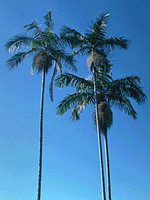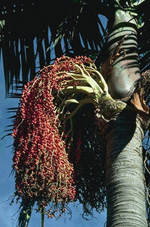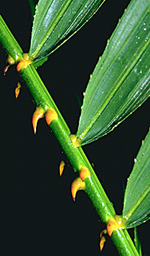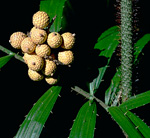 |
Palms are a large, diverse and mostly pantropical family, although some species extend into the subtropics and into dry regions where there is permanent subsurface water. In Australia, it is most diverse in rain forests of the north and north-east. Some species extend into drier savannah woodlands, and one even into Central Australia where it is restricted to sheltered valleys with permanent water. A few extend down the east coast into southern New South Wales and far eastern Victoria.
Characteristic features of the family Arecaceae in Australia include: - usually tree-like with a stout, usually unbranched woody trunk and large crown of leaves; some species are climbing or trunkless
- leaves often very large, pinnate or palmate, with prominently sheathing bases
- flowers small, 3- or 6-partite, often waxy, in large panicles borne among the leaves of the crown
- ovary superior, 3-celled, usually with a sessile stigma, developing into round, sometimes brightly coloured, dry or fleshy drupes (often appearing like small coconuts)
Description
Evergreen trees, shrubs, or woody vines climbing by hooks. Vegetative reproduction by rhizomes. Stems unarmed or with prickles or spines arising from stem surface; nodes conspicuously swollen or not conspicuously swollen; internodes spongy or pithy. Internal secretions not obvious. Plants glabrous or with simple, non-glandular, unicellular hairs. Leaves alternate and spiral, often apically clustered, petiolate, or rarely peltate. Stipule-like lobes absent. Lamina simple or once compound, rarely bicompound, palmate, paripinnate or imparipinnate, symmetric or conspicuously asymmetric, palmatifid or palmatisect or bipinnatifid, tripinnatifid, etc; lamina/leaflets lanceolate, ovate, oblanceolate, oblong, flabellate or rarely orbicular; base cuneate, attenuate, cordate, oblique; margins entire, dentate or spiny, ±flat; venation parallel, with the midrib conspicuous or inconspicuous, and the tertiary venation not reticulate; surfaces not punctate; leathery or hard and spinose. Leaf ligule present or absent. Leaflet shape filiform, acicular, subulate, linear, lanceolate, oblanceolate, flabellate, or narrow- or oblique-cuneate; margins entire, dentate or spiny; ±flat. Male and female flowers occurring on the same plant, or with all the flowers bisexual. Inflorescences terminal or axillary, consisting of capitula, spadices, spikes, racemes, panicles or solitary flowers. Spathes present. Bracts and bracteoles present. Pollination by insects. Flowers fragrant or malodorous; sessile or stalked. Floral disc absent; nectaries absent. Perianth regular, of 2 dissimilar whorls or all whorls ±similar, with 6 segments, imbricate or valvate in bud. Calyx segments free or fused, with 3 sepals or lobes, herbaceous, leathery or succulent. Corolla segments free or fused, with 3 petals or lobes, alternating with the sepals or calyx lobes; corolla cup-shaped, white, cream, yellow or green, or rarely pink, without contrasting markings, membranous, waxy, succulent or leathery; claws absent; lobes ±entire or ciliate or fimbriate. Fertile stamens 3, 6, or 10–numerous, alternating with or opposite to the sepals or calyx lobes, free or at least partly fused to the corolla segments or lobes, free of the ovary and style, distinct from each other, grouped or fused into bundles or fused by their filaments into an open or closed tube, all ±equal. Staminal filaments sometimes distinctly flattened. Anthers dorsifixed or basifixed, versatile or not versatile, opening sideways, outwards or inwards by longitudinal slits; 2 (–4)-celled. Ovary superior and sessile. Carpels rarely 1, usually 3, fused, or rarely free; ovary with 3 locules. Style terminal, single and unbranched, or single and branched above, sometimes very short. Ovules 1 per locule, stalked or sessile; placentation axile. Fruit a fleshy, indehiscent berry or a drupe, rarely viviparous; the perianth on the maturing fruit deciduous or dry and persistent. Disseminule macro-surface featureless or with imbricate scales; micro-surface ±smooth, ruminate or rugose, white, red, pink, brown or black, glossy or dull. Seeds 1–10 per fruit. Aril absent. Cotyledons 0. Embryo straight.
(Note: this description has been generated from the coded data compiled for the key. Any errors in the key data will be reflected in the descriptions.)
A treatment of the family Arecaceae has not yet been published in the Flora of Australia. It will appear in Volume 39.
Australian genera of Arecaceae (as recognised for the Flora of Australia)
* = all species introduced
Archontophoenix
Arenga
Bacularia
Calamus
Carpentaria
Caryota
Corypha
Gronophyllum
Gulubia
Hedyscepe
Howea
Hydriastele
Laccospadix
Lepidorrhachis
Licuala
Linospadix
Livistona
Normanbya
Nypa
Orania
Oraniopsis
*Phoenix
Ptychosperma
Woodyetia
*Washingtonia

|
  |

Archontophoenix cunninghamiana (habit)
Photo: M.Fagg © ANBG

Archontophoenix cunninghamiana (inflorescence)
Photo: M.Fagg © ANBG

Calamus moti (leaf rhachis showing hooked prickles)
Photo: H.Nicholson © H. & N. Nicholson

Calamus muelleri (fruits)
Photo: H.Nicholson © H. & N. Nicholson

|

| |